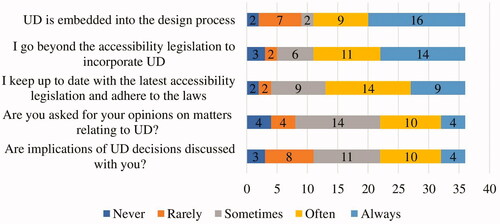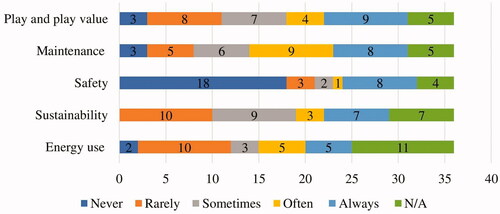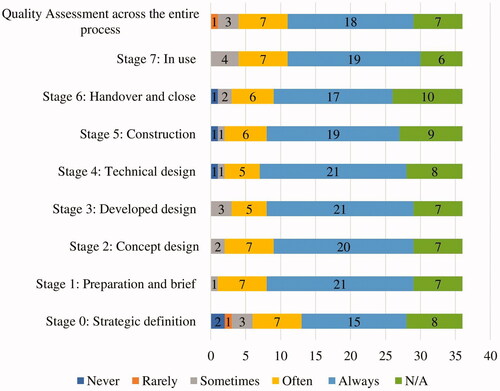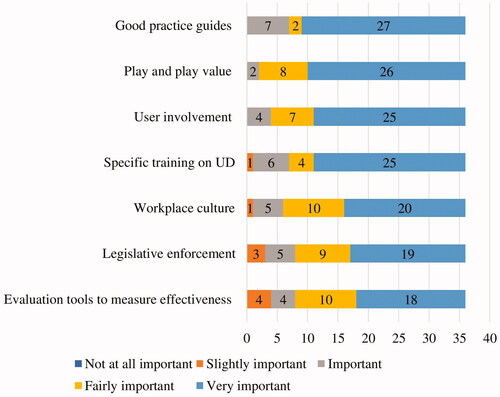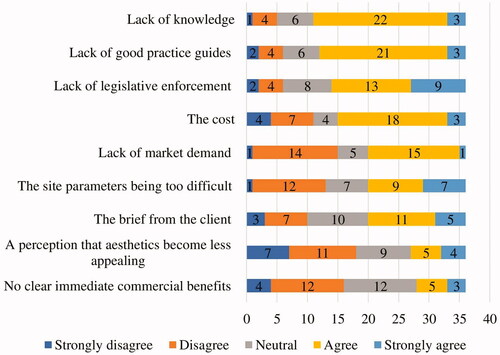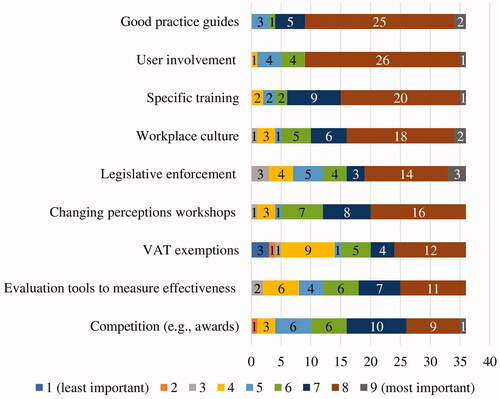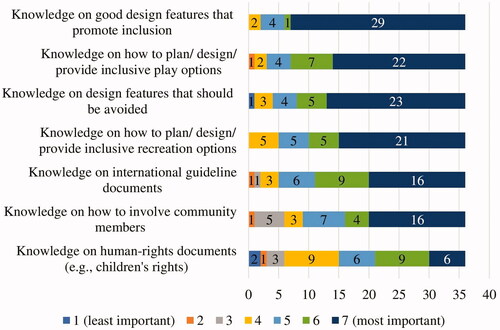Abstract
Globally, Universal Design (UD) is promoted as an evidence-informed approach for planning and designing accessible and inclusive public playgrounds, which are valuable sites for outdoor play in child-friendly cities. However, it remains unclear the extent to which UD has been implemented in public playgrounds. The purpose of this study was to explore the extent to which UD is implemented, from the perspectives of playground professionals in the Republic of Ireland. A descriptive, cross-sectional online survey was used to gather data. Data analysis revealed that playground professionals recognise the importance of UD for planning, designing, and providing public playgrounds for inclusion, and implement UD in various ways. Still, a lack of knowledge and good practice guides for embedding UD, constitute significant barriers. Numerous opportunities, initiatives and training prospects were identified to better support the implementation of UD. Moreover, further research with ‘professional experts’ and ‘user-experts’ is required to strengthen socio-spatial inclusion.
Play is such an important part of childhood that it is enshrined as a fundamental human right of all children in Article 31 of the United Nations Convention on the Rights of the Child (UNCRC) (United Nations, Citation1989). The value of play for children’s development, health, and wellbeing is increasingly recognised (Milteer, Ginsburg, Mulligan, & Committee On Psychosocial Aspects Of Child & Family Health, Citation2012; Moore & Lynch, Citation2018), and outdoor play is a significant contributor to these positive outcomes (Loebach, Sanches, Jaffe, & Elton-Marshall, Citation2021; Tremblay et al., Citation2015). Outdoor play refers to play that takes place outside, and is typically active, freely chosen, process rather than outcome oriented, and intrinsically motivating (Bundy, Citation1993). When children play outdoors, they tend to be physically active (Gray et al., Citation2015), think creatively (Clements, Citation2004), solve problems (Burdette & Whitaker, Citation2005), interact with peers (Dowdell, Gray, & Malone, Citation2011), learn important motor, social, emotional and cognitive skills (Brussoni et al., Citation2015; Burdette & Whitaker, Citation2005; Clements, Citation2004), and develop a more positive relationship with the natural environment (Bixler, Floyd, & Hammitt, Citation2002).
Despite the known benefits, researchers have noted a decline in children’s outdoor play in recent decades’ (Dodd, FitzGibbon, Watson, & Nesbit, Citation2021; Loebach et al., Citation2021; Tremblay et al., Citation2015). Evidence suggests that multiple ongoing societal shifts have contributed to this decline, such as lifestyle changes (Tremblay et al., Citation2015), urbanisation (Karsten, Citation2005), neighbourhood social and environmental conditions (Loebach & Gilliland, Citation2016; Ross, Wood, & Searle, Citation2020), children’s safety and parental concerns (Brussoni, Olsen, Pike, & Sleet, Citation2012; Brussoni et al., Citation2020), and changing social norms around children’s mobility (Kyttä, Hirvonen, Rudner, Pirjola, & Laatikainen, Citation2015; Tremblay et al., Citation2015). The subsequent effects on children’s health, development, and wellbeing are concerning as researchers have attributed the rise of childhood obesity (Tremblay et al., Citation2015) and childhood psychopathology (Gray, Citation2011) at least partly to the reduction in outdoor play.
Consequently, policymakers, practitioners, and communities are working together to mediate this impact, by delivering better play opportunities in urban locations (Arup & The Lego Foundation, Citation2020; Vincelot, Citation2019) as 60 per cent of the world’s children are projected to live in cities by the year 2030 (UNICEF, Citation2019). Target 11.7 of Sustainable Development Goal 11 states ‘by 2030, provide universal access to safe, inclusive, and accessible, green and public spaces…’ (United Nations General Assembly, Citation2015, p. 22). One way to ensure equitable play opportunities in public open space is through the planning and provision of playgrounds (Jansson, Citation2010); thus, those that plan, design, and/or provide (referred to hereafter as playground professionals) public playgrounds are expected to provide accessible and inclusive public playgrounds, which is the primary focus of this paper.
Public playgrounds are usually located in neighbourhoods or at locations that playground patrons travel to (Daniels & Johnson, Citation2009), and offer structured, free-of-charge, safe spaces for children to play (Lundman, Citation2021). They typically contain play equipment and structures with paths to and between equipment (Brown et al., Citation2021), and have evolved in recent decades to include natural materials and landscaped elements alongside equipment designed for children (Herrington & Studtmann, Citation1998; Woolley & Lowe, Citation2013). The design of playgrounds, however, is often shaped by an idealised norm of children’s bodies, mobilities, and abilities (Brown et al., Citation2021). Subsequently, many children and their families, who do not fit within such norms, experience public playgrounds as sites of spatial and social exclusion because of physical barriers to access and social barriers to participation (Lynch, Moore, Edwards, & Horgan, Citation2020; Prellwitz & Skär, Citation2007, Citation2016; Ripat & Becker, Citation2012).
Nevertheless, the right of all children to play and to access the physical environment for play is recognised in Article 31 of the UNCRC (UN, 1989) and further supported in the UN Convention on the Rights of Persons with Disabilities (UNCRPD) (United Nations, Citation2006). However, challenges in implementing these rights prompted the publications of General Comment No. 17 (GC17) on play and leisure (Committee on the Rights of the Child, Citation2013) and of General Comment No. 2 (GC2) on accessibility (Committee on the Rights of Persons with Disabilities, Citation2014) to address society’s failure to protect and provide for children’s right to play and disability rights more broadly. Both General Comments endorse Universal Design for providing conceptual guidance for designing environments (including public play environments) that are accessible and inclusive for all.
The term Universal design (UD) was first introduced by Ronald Mace in 1985 to describe ‘a way of designing a building or facility, at little or no extra cost, so that it is both attractive and functional for all people, disabled or not’ (Mace, Citation1985, p. 147). Later, the UNCRPD defined UD as ‘the design of products, environments, programmes and services to be usable by all people, to the greatest extent possible, without the need for adaptation or specialised design’ (United Nations, Citation2006, p. 4). While related design concepts exist, for example, inclusive design (Coleman, Citation1994; Imrie & Hall, Citation2001) and design for all (European Institute for Design & Disability, Citation2004), what differentiates UD is that it is underpinned by seven principles and eight goals ().
Table 1. Seven principles and eight goals of universal design.
Although UD has become widely accepted by supranational institutions such as the UN and the World Health Organisation, researchers within various design disciplines acknowledge that the implementation of UD is often hampered by knowledge-based, attitudinal, and practical barriers (Ielegems, Herssens, Nuyts, & Vanrie, Citation2019). Knowledge-based barriers include a lack of knowledge on UD (Dong, Clarkson, Ahmed, & Keates, Citation2004; Goodman, Dong, Langdon, & Clarkson, Citation2006) and limited education in UD (Goodman-Deane, Langdon, & Clarkson, Citation2010; Manley, de Graft-Johnson, & Lucking, Citation2011). Attitudinal barriers include associating UD merely with accessibility (Ielegems et al., Citation2019; Ostroff, Citation2011; Steinfeld & Maisel, Citation2012), incorrect perceptions that UD sacrifices aesthetics, raises costs, requires a more complex design process, and slows down time to market (Dong et al., Citation2004; Goodman et al., Citation2006; Goodman-Deane et al., Citation2010). Practical barriers include time and budget limitations, the client's influence, or the company’s culture (Dong et al., Citation2004; Goodman et al., Citation2006), barriers to evaluation (O Shea, Pavia, Dyer, Craddock, & Murphy, Citation2016), and limited economic incentives and recognition in design awards (Heylighen, Schijlen, Van der Linden, Meulenijzer, & Vermeersch, Citation2016; Manley et al., Citation2011).
Within this context, barriers for implementing UD in the built environment also extends to playground design. Knowledge-based barriers include a lack of UD knowledge among playground professionals (Lynch, Moore, Edwards, & Horgan, Citation2019, Lynch et al., Citation2020; Prellwitz, Tamm, & Lindqvist, Citation2001; Prellwitz & Tamm, Citation1999; Sterman, Naughton, Bundy, Froude, & Villeneuve, Citation2019; Woolley & Lowe, Citation2013), a lack of evidence on the effectiveness of UD (Moore, Lynch, & Boyle, Citation2020; Moore & Lynch, Citation2015), and inconsistent terminology being used to describe to describe non-discriminatory planning and design concepts (Moore, Boyle, & Lynch, Citation2022). Attitudinal barriers include incorrect perceptions that UD raises costs (Lynch et al., Citation2019). Practical barriers include lack of play-policy that incorporates UD (Lynch, Moore, & Prellwitz, Citation2018; Van Melik & Althuizen, Citation2020), and limited efforts to translate UD principles to include play value principles (Casey, Citation2017; Lynch et al., Citation2018). Also, among landscape architects, there is a consensus that there is a need for play-specific approaches to playground design (Jansson, Citation2010), a robust evidence-based (Refshauge, Stigsdotter, Lamm, & Thorleifsdottir, Citation2015), and good quality urban parks (Guo & Mell, Citation2021).
Therefore, this review identifies that many communities are struggling to implement UD and facilitate the provision of accessible and inclusive public playgrounds in urban locations. Yet, UD is endorsed by the UN for providing conceptual guidance for designing environments (including public play environments) that are accessible and inclusive of all. Instrumental in ensuring the implementation of UD are those responsible for the design, building, and commissioning of public playgrounds. Thus, there is an urgent need to explore the ways in which UD is understood and implemented by playground professionals to overcome the inequalities faced by diverse children and families in public playgrounds. While some evidence exists concerning how UD is understood and implemented by playground professionals in the Republic of Ireland (Lynch et al., Citation2019, Citation2020), these studies were limited to one urban location.
Therefore, this study aims to provide a comprehensive ‘first impression’ of the ways in which UD is understood and implemented by a national sample of playground professionals in the Republic of Ireland and accordingly, lay the groundwork for future research. This study aims at addressing the following research questions: (1) how is UD understood? (2) in what ways is UD implemented? (3) what legislation, policies, and/or guidance documents are utilised? (4) what are the opportunities and barriers to implementing UD? and (5) what training is important to support the implementation of UD? These questions are important for generating awareness and informing the field of landscape research and its allied fields for future decisions that can impact the planning, designing, and provision of accessible and inclusive public playgrounds, in sustainable child-friendly cities.
Methodology
Study design
A descriptive, cross-sectional online survey was used to gather data. Permission to undertake the study was granted by the Social Research Ethics Committee, University College Cork, in December 2019 (Log 2019-195).
Study setting
The Republic of Ireland is divided over four provinces (Munster, Leinster, Ulster, and Connacht) with 31 local authorities that are responsible for a range of local services, including public playgrounds. In 2012, the Department of Children, Equality, Disability, Integration, and Youth established the Local Authority Play and Recreation Network (LAPRN) which comprises of key local authority staff responsible for the local delivery of play and recreation services (including public playgrounds).
Questionnaire
Following a comprehensive review of the academic literature (Moore et al., Citation2020) and grey literature [Manuscript submitted for publication], the research team developed a questionnaire consisting of 26 items for the study. The draft questionnaire was reviewed by two UD experts, from the Centre for Excellence in Universal Design in Ireland. The revised questionnaire was pilot tested with four professionals with knowledge on the design of built environments and UD to identify possible operational errors (it was not pilot tested with playground professionals so that potential participants would not be excluded in this study).
The final questionnaire consisted of 15 quantitative items (closed questions including multiple choice and Likert scales) and 11 qualitative items (open-ended questions).
Sampling
Purposive sampling techniques were employed, and recruitment email invitations, with a link to the questionnaire, were sent to sixty groups (). A gatekeeper responsible for the LAPRN distributed the survey to LAPRN members. Also, eleven individual playground professionals were contacted directly. Snowball sampling was encouraged; thus, potential participants were contacted directly by the researcher or via gatekeeper(s).
Table 2. Groups contacted for sampling.
Data collection
Data were collected via Google Forms through an anonymous link distributed to playground professionals in April and May 2021 (7-weeks). From the outset, potential participants were provided with information concerning the research purpose, confidentiality of information, and advised that by completing and submitting the survey they were consenting to participate.
Data analysis
For the 15 quantitative items, descriptive statistics were used to describe, synthesise, and summarise the data. Answers to the 11 qualitative items were analysed using descriptive qualitative content analysis. Data analysis was led by the first author and confirmed by the remaining authors.
Results
36 playground professionals from all provinces in the Republic of Ireland completed the survey. Given the multiple routes to distributing the survey, it was not possible to determine a response rate. Also, because this survey was anonymous, no information was obtained regarding non-responders.
A summary of respondents’ demographics and practice contexts is presented below, and main results are presented under the heading of each research question.
Respondents’ demographics and practice contexts
Data of 36 playground professionals were included ().
Table 3. Respondents’ demographics (n = 36).
Most respondents (n = 23; 63.9%) planned, designed, and provided playgrounds, and had 0–5 years (55.6%) professional experience. A further thirteen respondents (36.1%) listed their roles as ‘other’, which included, for example: ‘playground inspector/trainer’, and ‘play advocate’.
Respondents mainly practiced in the Leinster and Munster provinces (n = 26; 72.2%); six respondents (16.7%) had a broader remit which included multiple provinces in the Republic of Ireland (including Connacht) and multiple countries. One respondent (2.8%) listed their role in education. Information was also sought relating to respondents’ qualifications. Half of the respondents had qualifications in engineering (16.7%), architecture (16.7%), and landscape and/or horticulture (16.7%).
Main results
How is UD understood?
When asked to describe what they understand by the term UD, most respondents (n = 22; 61.1%) described UD as designing for: different abilities and/or disabilities, everyone, and for inclusion ().
Table 4. Understandings and applicability of UD for public playgrounds.
Moreover, respondents were asked how important UD is for public playground design (). Most respondents reported that UD was very important (n = 32, 88.9%); however, when asked who UD playgrounds are important for, only five respondents (13.9%) noted that UD playgrounds were for everyone. The remaining respondents defined their importance relating to specific characteristics, which is perhaps unsurprising when considering the ways in which UD is understood.
Also, when asked to determine what percentage of projects require knowledge about UD, only thirteen respondents (36.1%) reported that all projects require knowledge (). Also, thirteen respondents (36.1%) did not specify a percentage or deemed UD not applicable.
Overall, results suggest that although respondents value and adopt UD in principle, respondents seem to view UD as something to apply in specific circumstances as opposed to a standard design strategy for every playground. While a lack of knowledge has previously been identified as a barrier, results from this study reveal that a lack of understanding and the subsequent lack of UD knowledge meant that the design of playgrounds that benefit everyone was potentially hindered.
What legislation, policies, and/or guidance documents are utilised?
Respondents were asked to comment on what legislation and/or policies they refer to, relevant to UD and inclusion. lists the documents identified by most respondents (n = 29; 80.6%). However, almost one-fifth of the respondents (n = 7; 19.4%) determined that legislation/policy documents were not applicable or did not identify any documents.
Table 5. Legislation, policy, and/or guidance documents utilised.
Also, respondents were asked to identify what guideline documents they refer to. Despite an array of guideline documents listed by most respondents (n = 25; 69.4%), guideline documents were often listed interchangeably with legislation and/or policy documents (). Yet, eleven respondents (30.6%) determined that guidance documents were not applicable or did not identify any.
Overall, results suggest that most respondents value legislative, policy, and guidance documents; however, many respondents did not differentiate between documents that are mandatory (legislation and policy), or voluntary/optional (guidance documents). This lack of differentiation may be attributed to the lack of play-policy that incorporates UD, identified previously, and subsequently many playground professionals relied on guidance documents to support their practices.
In what ways is UD implemented?
Respondents were asked to provide examples of how they implemented UD in practice. Most respondents (n = 30; 83.3%) provided examples including: providing accessible and/or inclusive play equipment and/or spaces, consulting with stakeholders, making playgrounds accessible, selecting specific elements for a site, implementing UD at different design stages, and making playgrounds inclusive.
Also, respondents were asked to rate, the extent to which they address and/or are consulted on five UD issues (listed in ). Most respondents (n = 25; 69.5%) reported that they often or always embed UD into the design process and go beyond minimum accessibility legislation.
Overall, results suggest that most respondents go beyond mere accessibility legislation and implement UD in various ways; however, the implication of implementing UD is rarely or never a matter of discussion (n = 11, 30.5%) which potentially does not facilitate opportunities to learn from each other. This may subsequently contribute to a lack of evidence on the effectiveness of UD, previously identified in the literature review.
Respondents were subsequently asked to rate the extent to which they prioritise UD over six other factors (listed in ). One quarter of respondents (n = 9; 25.0%) reported that they always prioritise UD over cost, play and play value. Still, half of the respondents (n = 18; 50.0%) reported that they never prioritise UD over safety, suggesting that a ‘standards first’ approach continues to dominate in public playgrounds, a phenomenon previously described by Ball et al. (Citation2019).
Also, respondents were asked to rate the extent to which they implement UD in different design stages (listed in ). More than half of the respondents (n = 21; 58.3%) reported that they always implement UD at stages 1, 3, and 4. Eleven respondents (30.6%) reported that UD was mostly not applicable or that they never implement UD at stage 6.
What are the opportunities and barriers to implementing UD?
Respondents were asked to rate, on a scale of importance, the extent to which seven factors (listed in ) were important for implementing UD. Factors respondents considered to be most important (rated very important) were good practice guides for embedding UD (n = 27; 75.0%) along with play and play value (n = 26; 72.2%).
In contrast, respondents were asked to rate, on a scale of agreement, the extent to which they perceived nine factors (listed in ) as a barrier to implementing UD. The most perceived barriers (rated strongly agree or agree) were a lack of knowledge on UD (n = 25; 69.4%) and a lack of good practice guides for embedding UD (n = 24; 66.7%).
Respondents were subsequently asked to rate, on a scale of importance, the extent to which nine initiatives and practices (listed in ) would better support the implementation of UD. Initiatives and practices respondents considered to be most important (rated 8 and above on a nine-point scale) were good practice guides for embedding UD (n = 27; 75.0%) and user involvement (n = 27; 75.0%).
In sum, results suggest that respondents considered not only the built environment, but also what happens in public playgrounds (i.e. play). While Watchorn et al. (Citation2021) recently asserted that what people do in built environments is rarely considered, results from this study show that respondents do consider what people do in playgrounds. Nevertheless, a lack of knowledge on UD and the lack of availability of good practice guides for implementing UD constitute significant barriers to implementing UD; this lack of availability extends upon previously known barriers, identified in the literature review. Thus, it is not surprising that respondents identified good practice guides and user involvement as important to address these barriers and support the implementation of UD.
What training is important to support the implementation of UD?
Given that a lack of knowledge was identified as a barrier, most respondents reported that they would (n = 26; 72.2%) or may be (n = 7; 19.4%) interested in further education to support the implementation of UD. Two respondents identified that they would not be interested, while one respondent noted that there is ‘…no point in attending these workshops if decisionmakers don’t’.
Overall, further education was particularly desired (rated 6 and above on a seven-point scale) on knowledge on good design features that promote inclusion (n = 30; 83.3%) and knowledge on how to plan/design/provide inclusive play options (n = 29; 80.6%) (). While a lack of education on UD was previously acknowledged as a barrier to implementing UD, these results offer specific direction on pertinent areas that need to be addressed in future education efforts.
Almost all playground professionals identified that a half-day (n = 19; 52.8%) or full day (n = 16; 44.4%) training would suffice; one respondent (2.8%) identified a longer duration. In-person training was identified as the most preferred method (n = 20; 55.6%), followed by online e-courses (n = 11; 30.6%).
Discussion
This study aimed to create a comprehensive ‘first impression’ of the ways in which UD is understood and implemented by a national sample of playground professionals in the Republic of Ireland and, on this basis, lay the groundwork for future research. As we embark upon the 30th anniversary of the ratification of the UNCRC in Ireland in 1992, these results offer insights into the ways in which UD is understood and implemented, and provides policy makers, researchers, and educators with the information needed to more effectively address the barriers that playground professionals face in implementing UD.
Data analysis revealed that playground professionals, from diverse professional backgrounds, recognise the importance of UD for public playgrounds. However, knowledge-based barriers meant that few respondents recognised the importance of UD playgrounds for everyone. Instead, a strong reference to designing for disability was evident and UD was viewed as something to apply in specific circumstances. However, at the core of UD is the commitment to inclusion and the provision of environments that can fully be experienced by all people irrespective of age, size, gender, class, or (dis)ability (Disability Act, Citation2005; Gossett, Mirza, Barnds, & Feidt, Citation2009). Therefore, designing for disability is in stark contrast to the underlying philosophy of UD.
Moreover, few respondents acknowledged that all public playground projects require knowledge about UD. In fact, more than one-third of respondents identified that UD was not applicable to public playground design. However, UD for public playground design is endorsed by GC17 (Committee on the Rights of the Child, Citation2013), GC2 (Committee on the Rights of Persons with Disabilities, Citation2014), the UNCRPD (United Nations, Citation2006), and the new European standard EN 17210:2021 (National Standards Authority of Ireland, Citation2021). Thus, all public playground projects in the Republic of Ireland should require knowledge about UD.
Although knowledge-based barriers to implementing UD, confirms findings from previous studies with playground professionals (Lynch et al., Citation2019, Citation2020; Prellwitz et al., Citation2001; Prellwitz & Tamm, Citation1999; Sterman et al., Citation2019; Woolley & Lowe, Citation2013), practical barriers such as a lack of good practice guidance documents was a new finding. Confusion existed among the respondents as a sizeable proportion of them did not refer to guideline documents and sometimes failed to differentiate between what is mandatory (legislation and policy) and what is voluntary or optional (guidance documents). Given the strong focus on safety, it could be argued that the practices of these playground professionals were influenced primarily by a legislative, policy, and/or a standard imperative, which have different sets of outcomes to guidance documents which account for the entirety of playground design, as opposed to a specific component, such as safety.
However, a recent review of guidance documents in the international context found that guidance documents potentially make a fundamental contribution to the design of public playgrounds for inclusion [Manuscript submitted for publication]. Thus, the establishment of Irish guidelines specifically for an Irish context could overcome current barriers, and act as a middle ground for implementing UD. In this way, the establishment of guidelines, that also includes updating the National Play Policy in Ireland (National Children’s Office, Citation2004), needs to represent the entirety of playground design, with consideration for legislation, policy, and standards, as well as UD, play, and play value.
Despite these challenges, there are glimpses of hope. Indeed, a significant proportion of respondents identified that they go beyond mere accessibility legislation and implement UD in various ways and at different design stages, albeit inconsistently. This contrasts with previous research in other contexts that found that design professionals associate UD merely with accessibility (Lelegems et al., Citation2019; Ostroff, Citation2011; Steinfeld & Maisel, Citation2012). Moreover, although Watchorn et al. (Citation2021) recently asserted that the current discourse on UD and the built environment focuses on the person and the environment, with much less attention being directed towards what people do in built environments, consideration for wider aspects of provision was evident; specifically, play and play value were identified as very important.
Also, several efforts at the international, national, and local levels currently place UD at the forefront of the political and social agenda (Hitch, Larkin, Watchorn, & Ang, Citation2012). As mentioned, GC17 (Committee on the Rights of the Child, Citation2013), GC2 (Committee on the Rights of Persons with Disabilities, Citation2014), the UNCRPD (United Nations, Citation2006), and EN 17210:2021 (National Standards Authority of Ireland, Citation2021) endorse UD. Also, Ireland’s ratification of the UNCRPD in 2018 (United Nations, Citation2006), will further support the implementation of UD. Furthermore, the Community Participation (Disability) (Miscellaneous Provisions) Bill, Citation2019) currently before the Irish Government promotes the concept of UD and aims to expand upon the existing building regulations in Ireland to improve inclusiveness across Ireland.
Therefore, there is a growing awareness of, and demand for, public playgrounds that support participation and inclusion in urban contexts, and for playground professionals who are equipped to take up the challenge of implementing UD. In this study, respondents proposed numerous opportunities, initiatives, and training prospects to better support the implementation of UD. However, there is a significant need to embed knowledge on UD in education for playground professionals. Given the multi-disciplinary nature of the profession, as confirmed by the numerous disciplines represented in this study, this would warrant a multidisciplinary approach to educational provision and an interdisciplinary commitment to child-friendly cities.
While this study represents a rich insight into the ways in which a national sample of playground professionals in the Republic of Ireland understand and implement UD, there are some limitations which impact upon the extent to which the results can be generalised. First, despite the breath of recruitment strategies used, the overall population drawn from is very small as it represents a niche element of the design industry. Second, as this was a voluntary, online-based purposive and snowball sample study, no information was gathered on non-responders to the survey. As non-responders may be systematically different to the responders, results of this study should be interpreted accordingly. Finally, this survey involved playground professionals in the Republic of Ireland, thus, expanding this survey research to a larger sample (within and beyond the Irish context) is warranted, alongside more qualitative in-depth research. Specifically, further international research with ‘professional experts’ (i.e. playground professionals) and ‘user-experts’ (i.e. diverse public playground users and non-users) is required to strengthen knowledge on socio-spatial inclusion in sustainable child-friendly cities.
Acknowledgements
The authors would like to thank all those who have assisted in this research. We extend our sincere gratitude to all the respondents, without whom this study would not be possible. We are also extremely grateful for the support provided by Ruth O’ Reilly and Gerald Craddock in the Centre for Excellence in Universal Design at the National Disability Authority and for their guidance in reviewing the instrument, a draft version of the paper, and for sharing their expertise with us to strengthen the study. We would also like to acknowledge the generous contribution of Linda O’ Sullivan in the Department of Children, Equality, Disability, Integration and Youth, and to all gatekeepers for their assistance in recruiting participants to the study. Sincere thanks are also due to the anonymous reviewers for their important feedback during the review process. Finally, the first author’s PhD research is funded by an Irish Research Council award; the second and third authors supervise this PhD research.
Disclosure statement
No potential conflict of interest was reported by the author(s).
Additional information
Funding
Notes on contributors
Alice Moore
Alice Moore is a PhD Candidate (Irish Research Council funded researcher) in the Department of Occupational Science and Occupational Therapy, University College Cork, Ireland. Alice’s PhD explores the barriers and opportunities for diverse users/non-users (child and adult users/non-users with and without disabilities) to enjoy their rights to play and leisure in public playgrounds, and the potential of Universal Design to support outdoor play, social participation, and inclusion in outdoor playspaces.
Helen Lynch
Helen Lynch is Senior Lecturer in the Department of Occupational Science and Occupational Therapy, University College Cork, Ireland, and a Research Associate of the Institute for Social Sciences in the Twenty First Century. Helen supervises Alice’s PhD research and is currently a Co-Principal Investigator for a HORIZON 2020 Marie Skłodowska-Curie grant no. 720824: P4play.
Bryan Boyle
Bryan Boyle is Lecturer in the Department of Occupational Science and Occupational Therapy, University College Cork, Ireland. Bryan supervises Alice’s PhD research and is currently engaged in the HORIZON 2020 Marie Skłodowska-Curie grant no. 720824: P4play, where Bryan is investigating digital play spaces across childhood.
References
- Arup & The Lego Foundation. (2020). Reclaiming play in cities: The real play coalition approach. Retrieved from https://www.realplaycoalition.com/reclaiming-play-in-cities-report/.
- Ball, D. J., Brussoni, M., Gill, T. R., Harbottle, H., & Spiegal, B. (2019). Avoiding a dystopian future for children's play. International Journal of Play, 8(1), 3–10. doi:10.1080/21594937.2019.1582844
- Bixler, R. D., Floyd, M. F., & Hammitt, W. E. (2002). Environmental socialization: Quantitative tests of the childhood play hypothesis. Environment and Behavior, 34(6), 795–818. doi:10.1177/001391602237248
- Brown, D., Ross, T., Leo, J., Buliung, R., Shirazipour, C. H., Latimer, A. E., & Arbour-Nicitopoulos, K. P. (2021). A scoping review of evidence-informed recommendations for designing inclusive playgrounds. Frontiers in Rehabilitation Sciences (Advance online publication). doi:10.3389/fresc.2021.664595
- Brussoni, M., Gibbons, R., Gray, C., Ishikawa, T., Sandseter, E. B. H., Bienenstock, A., … Janssen, I. (2015). What is the relationship between risky outdoor play and health in children? A systematic review. International Journal of Environmental Research and Public Health, 12(6), 6423–6454. doi:10.3390/ijerph120606423
- Brussoni, M., Lin, Y., Han, C., Janssen, I., Schuurman, N., Boyes, R., … Mâsse, L. C. (2020). A qualitative investigation of unsupervised outdoor activities for 10-to 13-year-old children: “I like adventuring but I don't like adventuring without being careful”. Journal of Environmental Psychology (Advance online publication). doi:10.1016/j.jenvp.2020.101460
- Brussoni, M., Olsen, L. L., Pike, I., & Sleet, D. A. (2012). Risky play and children’s safety: Balancing priorities for optimal child development. International Journal of Environmental Research and Public Health, 9(9), 3134–3148. doi:10.3390/ijerph9093134
- Bundy, A. C. (1993). Assessment of play and leisure: Delineation of the problem. American Journal of Occupational Therapy, 47(3), 217–222. doi:10.5014/ajot.47.3.217
- Burdette, H. L., & Whitaker, R. C. (2005). Resurrecting free play in young children: Looking beyond fitness and fatness to attention, affiliation, and affect. Archives of Pediatrics & Adolescent Medicine, 159(1), 46–50. doi:10.1001/archpedi.159.1.46
- Casey, T. (2017). Outdoor play and learning in the landscape of children’s rights. In T. Waller, E. Arlemalm-Hagser, E. B. H. Sandseter, L. Lee-Hammond, K. Lekies, & S. Wyver (Eds.), The SAGE Handbook of Outdoor Play and Learning (pp. 362–377). London: Sage.
- Clements, R. (2004). An investigation of the state of outdoor play. Contemporary Issues in Early Childhood, 5(1), 68–80. doi:10.2304/ciec.2004.5.1.10
- Coleman, R. (1994, August 15–19). The case for inclusive design – an overview. Proceedings of the 12th Triennial Congress, International Ergonomics Association and the Human Factors Association, Toronto, Canada.
- Committee on the Rights of Persons with Disabilities. (2014). General comment No. 2 on Article 9: Accessibility. Retrieved from https://documents-dds-ny.un.org/doc/UNDOC/GEN/G14/033/13/PDF/G1403313.pdf?OpenElement.
- Committee on the Rights of the Child. (2013). General COMMENT No. 17 on the right of the child to rest, leisure, play, recreational activities, cultural life and the arts. Retrieved from https://www.refworld.org/docid/51ef9bcc4.html.
- Community Participation (Disability) (Miscellaneous Provisions) Bill. (2019). (Ireland). Retrieved from https://data.oireachtas.ie/ie/oireachtas/bill/2019/39/eng/initiated/b3919s.pdf
- Connell, B., Jones, M., Mace, R., Mueller, J., Mullick, A., Ostroff, E., … Vanderheiden, G. (1997). The principles of universal design. Retrieved from https://projects.ncsu.edu/design/cud/about_ud/udprinciplestext.htm
- Daniels, D. M., & Johnson, E. L. (2009). The impact of community-built playgrounds on the community. Journal of Trauma and Acute Care Surgery, 67(1), S16–S19. Retrieved from doi:10.1097/TA.0b013e3181ac1400
- Disability Act 2005. Number 14 of 2005. https://www.irishstatutebook.ie/eli/2005/act/14/enacted/en/html
- Dodd, H. F., FitzGibbon, L., Watson, B. E., & Nesbit, R. J. (2021). Children’s play and independent mobility in 2020: Results from the British children’s play survey. International Journal of Environmental Research and Public Health, 18(8), 4334. doi:10.3390/ijerph18084334
- Dong, H., Clarkson, P. J., Ahmed, S., & Keates, S. (2004). Investigating perceptions of manufacturers and retailers to inclusive design. The Design Journal, 7(3), 3–15. doi:10.2752/146069204789338398
- Dowdell, K., Gray, T., & Malone, K. (2011). Nature and its influence on children's outdoor play. Journal of Outdoor and Environmental Education, 15(2), 24–35. doi:10.1007/BF03400925
- European Institute for Design and Disability. (2004). The EIDD Stickholm Declaration. Retrieved from https://dfaeurope.eu/wordpress/wp-content/uploads/2014/05/stockholm-declaration_english.pdf
- Goodman, J., Dong, H., Langdon, P., & Clarkson, P. (2006). Increasing the uptake of inclusive design in industry. Gerontechnology, 5(3), 140–149. doi:10.4017/gt.2006.05.03.003.00
- Goodman-Deane, J., Langdon, P., & Clarkson, J. (2010). Key influences on the user-centred design process. Journal of Engineering Design, 21(2–3), 345–373. doi:10.1080/09544820903364912
- Gossett, A., Mirza, M., Barnds, A. K., & Feidt, D. (2009). Beyond access: A case study on the intersection between accessibility, sustainability, and universal design. Disability and Rehabilitation: Assistive Technology, 4(6), 439–450. doi:10.3109/17483100903100301
- Gray, C., Gibbons, R., Larouche, R., Sandseter, E. B. H., Bienenstock, A., Brussoni, M., … Pickett, W. (2015). What is the relationship between outdoor time and physical activity, sedentary behaviour, and physical fitness in children? A systematic review. International Journal of Environmental Research and Public Health, 12(6), 6455–6474. doi:10.3390/ijerph120606455
- Gray, P. (2011). The decline of play and the rise of psychopathology in children and adolescents. American Journal of Play, 3, 443–463.
- Guo, Y., & Mell, I. (2021). The planning and design of good quality urban parks in China: The perspectives of technical professionals. Landscape Research, 46(8), 1106–1120. doi:10.1080/01426397.2021.1948517
- Herrington, S., & Studtmann, K. (1998). Landscape interventions: New directions for the design of children's outdoor play environments. Landscape and Urban Planning, 42(2–4), 191–205. doi:10.1016/S0169-2046(98)00087-5
- Heylighen, A., Schijlen, J., Van der Linden, V., Meulenijzer, D., & Vermeersch, P. W. (2016). Socially innovating architectural design practice by mobilising disability experience. An exploratory study. Architectural Engineering and Design Management, 12(4), 253–265. doi:10.1080/17452007.2016.1172197
- Hitch, D., Larkin, H., Watchorn, V., & Ang, S. (2012). Community mobility in the context of universal design: Inter‐professional collaboration and education. Australian Occupational Therapy Journal, 59(5), 375–383. doi:10.1111/j.1440-1630.2011.00965.x
- Lelegems, E., Herssens, J., Nuyts, E., & Vanrie, J. (2019). Drivers and barriers for universal designing: A survey on architects’perceptions. Journal of Architectural and Planning Research, 36(3), 181–197.
- Imrie, R., & Hall, P. (2001). Inclusive Design: Designing And Developing Accessible Environments. London: Spon Press.
- Jansson, M. (2010). Attractive playgrounds: Some factors affecting user interest and visiting patterns. Landscape Research, 35(1), 63–81. doi:10.1080/01426390903414950
- Karsten, L. (2005). It all used to be better? Different generations on continuity and change in urban children's daily use of space. Children's Geographies, 3(3), 275–290. doi:10.1080/14733280500352912
- Kyttä, M., Hirvonen, J., Rudner, J., Pirjola, I., & Laatikainen, T. (2015). The last free-range children? Children’s independent mobility in Finland in the 1990s and 2010s. Journal of Transport Geography, 47, 1–12. doi:10.1016/j.jtrangeo.2015.07.004
- Loebach, J., & Gilliland, J. (2016). Neighbourhood play on the endangered list: examining patterns in children's local activity and mobility using GPS monitoring and qualitative GIS. Children's Geographies, 14(5), 573–589. doi:10.1080/14733285.2016.1140126
- Loebach, J., Sanches, M., Jaffe, J., & Elton-Marshall, T. (2021). Paving the way for outdoor play: Examining socio-environmental barriers to community-based outdoor play. International Journal of Environmental Research and Public Health, 18(7), 3617. doi:10.3390/ijerph18073617
- Lundman, R. (2021). Coping with standards: Integrating art and safety into the design of a creative playground. Journal of Planning Education and Research (Advance Online Publication). doi:10.1177/0739456X21994650
- Lynch, H., Moore, A., Edwards, C., & Horgan, L. (2019). Community parks and playgrounds: Intergenerational participation through universal design. National Disability Authority. Retrieved from http://nda.ie/Publications/Others/Research-Promotion-Scheme/Community-Parks-and-Playgrounds-Intergenerational-Participation-through-Universal-Design1.pdf
- Lynch, H., Moore, A., Edwards, C., & Horgan, L. (2020). Advancing play participation for all: The challenge of addressing play diversity and inclusion in community parks and playgrounds. British Journal of Occupational Therapy, 83(2), 107–117. doi:10.1177/0308022619881936
- Lynch, H., Moore, A., & Prellwitz, M. (2018). From policy to play provision: Universal design and the challenges of inclusive play. Children, Youth & Environments, 28(2), 12–34. doi:10.7721/chilyoutenvi.28.2.0012
- Mace, R. (1985). Universal design: Barrier free environments for everyone. Designers West, 33(1), 147–152.
- Manley, S., de Graft-Johnson, A., & Lucking, K. (2011). Disabled architects: Unlocking the potential for practice. Royal Institute of British Architects and the University of the West of England. Retrieved from https://uwe-repository.worktribe.com/output/958093/disabled-architects-unlocking-the-potential-for-practice
- Milteer, R. M., Ginsburg, K. R., & Mulligan, D. A, Committee On Psychosocial Aspects Of Child And Family Health (2012). The importance of play in promoting healthy child development and maintaining strong parent-child bond: Focus on children in poverty. Pediatrics, 129(1), e204–e213. doi:10.1542/peds.2011-2953
- Moore, A., Boyle, B., & Lynch, H. (2022). Designing for inclusion in public playgrounds: a scoping review of definitions, and utilization of universal design. Disability and Rehabilitation: Assistive Technology (Advance Online Publication). doi:10.1080/17483107.2021.2022788
- Moore, A., & Lynch, H. (2015). Accessibility and usability of playground environments for children under 12: A scoping review. Scandinavian Journal of Occupational Therapy, 22(5), 331–344. doi:10.3109/11038128.2015.1049549
- Moore, A., & Lynch, H. (2018). Understanding a child’s conceptualisation of well-being through an exploration of happiness: The centrality of play, people and place. Journal of Occupational Science, 25(1), 124–141. doi:10.1080/14427591.2017.1377105
- Moore, A., Lynch, H., & Boyle, B. (2020). Can universal design support outdoor play, social participation, and inclusion in public playgrounds? A Scoping Review. Disability and Rehabilitation (Advance Online Publication). doi:10.1080/09638288.2020.1858353
- National Children’s Office. (2004). Ready, Steady, Play! A National Play Policy. Dublin: The Stationary Office.
- National Standards Authority of Ireland. (2021). Accessibility and usability of the built environment – functional requirements (I.S. EN17210:2021&LC 2021). Dublin: NSAI.
- O Shea, E. C., Pavia, S., Dyer, M., Craddock, G., & Murphy, N. (2016). Measuring the design of empathetic buildings: A review of universal design evaluation methods. Disability and Rehabilitation, 11(1), 13–21. doi:10.3109/17483107.2014.921842
- Ostroff, E. (2011). Universal design: an evolving paradigm. In W. F. Preiser, & K. Smith (Eds.), Universal Design Handbook (pp. 1.3–1.11). London, UK: McGraw Hill.
- Prellwitz, M., & Skär, L. (2007). Usability of playgrounds for children with different abilities. Occupational Therapy International, 14(3), 144–155. doi:10.1002/oti.230
- Prellwitz, M., & Skär, L. (2016). Are playgrounds a case of occupational injustice? Experiences of parents of children with disabilities. Children, Youth and Environments, 26(2), 28–42. doi:10.7721/chilyoutenvi.26.2.0028
- Prellwitz, M., & Tamm, M. (1999). Attitudes of key persons to accessibility problems in playgrounds for children with restricted mobility: A study in a medium-sized municipality in northern Sweden. Scandinavian Journal of Occupational Therapy, 6(4), 166–173. doi:10.1080/110381299443645
- Prellwitz, M., Tamm, M., & Lindqvist, R. (2001). Are playgrounds in Norrland (Northern Sweden) accessible to children with restricted mobility? Scandinavian Journal of Disability Research, 3(1), 56–68. doi:10.1080/15017410109510768
- Refshauge, A. D., Stigsdotter, U. K., Lamm, B., & Thorleifsdottir, K. (2015). Evidence-based playground design: Lessons learned from theory to practice. Landscape Research, 40(2), 226–246. doi:10.1080/01426397.2013.824073
- Ripat, J., & Becker, P. (2012). Playground usability: What do playground users say? Occupational Therapy International, 19(3), 144–153. doi:10.1002/oti.1331
- Ross, A., Wood, L., & Searle, M. (2020). The indirect influence of child play on the association between parent perceptions of the neighborhood environment and sense of community. Health & Place (Advance online publication). doi:10.1016/j.healthplace.2020.102422
- Steinfeld, E., & Maisel, J. (2012). Universal Design: Creating Inclusive Environments. Hoboken, NJ: John Wiley & Sons.
- Sterman, J. J., Naughton, G. A., Bundy, A. C., Froude, E., & Villeneuve, M. A. (2019). Planning for outdoor play: Government and family decision-making. Scandinavian Journal of Occupational Therapy, 26(7), 484–495. doi:10.1080/11038128.2018.1447010
- Tremblay, M. S., Gray, C., Babcock, S., Barnes, J., Bradstreet, C. C., Carr, D., … Brussoni, M. (2015). Position statement on active outdoor play. International Journal of Environmental Research and Public Health, 12(6), 6475–6505. doi:10.3390/ijerph120606475
- UNICEF. (2019). Advantage or paradox? The challenge for children and young people of growing up urban. Retrieved from https://data.unicef.org/resources/urban-paradox-report/
- United Nations. (1989). Convention on the rights of the child. https://treaties.un.org/pages/ViewDetails.aspx?src=IND&mtdsg_no=IV-11&chapter=4&lang=en
- United Nations. (2006). Convention on the rights of persons with disabilities. https://www.un.org/development/desa/disabilities/convention-on-the-rights-of-persons-with-disabilities.html
- United Nations General Assembly. (2015). Transforming our world: The 2030 agenda for sustainable development. http://www.un.org/ga/search/view_doc.asp?symbol=A/70/L.1&Lang=E
- Van Melik, R., & Althuizen, N. (2020). Inclusive play policies: Disabled children and their access to Dutch playgrounds. Tijdschrift Voor Economische en Sociale Geografie (Advance Online Publication). doi:10.1111/tesg.12457
- Vincelot, J. (2019). Urban95: A global initiative linking early childhood development and the urban field. Cities & Health, 3(1–2), 40–45. doi:10.1080/23748834.2018.1538178
- Watchorn, V., Hitch, D., Grant, C., Tucker, R., Aedy, K., Ang, S., & Frawley, P. (2021). An integrated literature review of the current discourse around universal design in the built environment–is occupation the missing link? Disability and Rehabilitation, 43(1), 1–12. doi:10.1080/09638288.2019.1612471
- Woolley, H., & Lowe, A. (2013). Exploring the relationship between design approach and play value of outdoor play spaces. Landscape Research, 38(1), 53–74. doi:10.1080/01426397.2011.640432

